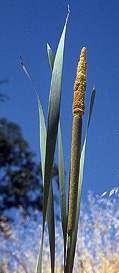
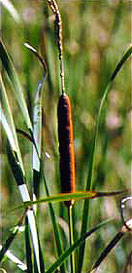
Searching for another food adventure, but not quite up for road kill quiche? Cattail pollen can satisfy a wild appetite without provoking the least bit of squeamishness. Its bright yellow color has eye appeal. The flavor is pleasant. Allergic to pollens? Well, there are all kinds of pollen, so if gathering the stuff doesn't cause you to take out your inhaler, you probably have nothing to worry about. Think pollen isn't a food? Remember, the expensive and esteemed spice, Saffron, is also pollen.


Step 1: Find a cattail patch. Cattails are tall reed-like plants growing in or around water. The leaf structure however is flattened, not rounded like bulrush. The "cat's tail" refers to the mature flower spike. When seed matures, it forms a tightly packed, brown cylinder. It resembles a corn dog on a stick more than a cat's tail. If the "cat's tail" is brown, you are probably too late to gather pollen.
Step 2: Take a moment. Give some thought. This is a generous plant. Pre-contact Native American usage of the plant was extensive. The new green leaf stalks can be split out and eaten like celery. Cahuilla and Mountain Maidu Indians wove the mature leaf stalk into mats or other useful items. The male flower's edible pollen was used like flour. Immature flowers (male and female) were eaten while still sheathed. The bloom stalk can be used as a fire stick when thoroughly dry, though the Indians at San Juan De Padua were reported to construct flutes from the stalk. The same flower later produces cattail fluff, versatile as insulation, tinder, cradle board padding, and wound dressing. The root stalks (corms) are rich in starch, and can be processed as a food. Consider too the cattail's role in supporting the web of life. As we gathered the pollen, we were aware of geese and teal, muskrats, fish sheltered in the tangled roots, marsh wrens, blackbirds, and an invisible but vocal bittern. What isn't there to like about the cattail? Take a moment to say please. Take a moment to say thank you.
Step 3: Find your cattail patch at the right time of year. Spring is the time to find cattail pollen, and spring follows April on its way to the mountains. When the plant sends up its new shoots, it also produces flowers. The upper portion of the cattail spike carries the male flowers and the pollen. The part we see in dried arrangements is the female part, and it will produce seed. The male flowers are short lived, tightly clustered, and small. What they lack in size they make up for in volumes of yellow pollen. When pollen is available, the top of the cattail spike looks like a fuzzy yellow finger above the green, partially sheathed cattail. The plant is wind pollinated, and the powdery pollen is quick to disperse with the slightest disturbance from wind or from eager gatherers. Once the pollen has launched itself into the air, the male flowers fall away, leaving the upper part of the spike bare. Getting hungry thinking about those pancakes? Try nibbling the green female flowers. They taste a little like broccoli, but not as strong. If you have missed the pollen producing season, consider one of the cattail's other gifts.
Step 4: Collect the pollen. Find a male flower spike which has not yet shed its pollen. Look for bright yellow tips above the green cattail. The flowers in the area where we gathered pollen were at their best when small flies could be seen clinging to the male flowers. They must have been there to take advantage of this resource too. (Yes, they did fly off. We didn't see a one in the collecting bag.) Carefully bend the flower into a collecting sack, and then tap it to release the pollen. It was not unusual to get a tablespoon or more from a single flower. Be careful not to break the stem. If you do, the pollen explodes off the tip, and the female flowers will fail to develop seed.
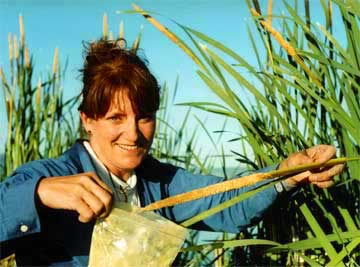
Step 5: Sift out any inedible bits. When the collecting bag is sufficiently full, bounce the bag until any odd bits of flower, bugs, etc. rise to the top. Just scoop them out. If they aren't alive, or too disgusting, keep them for added fiber. (Hey, you've heard of buckwheat cakes, haven't you?)
Step 6: Make the pancakes.
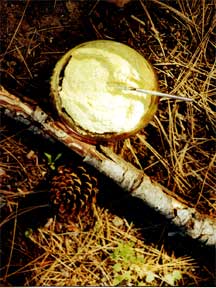 |
1/2 C cattail pollen 1/2 C all purpose flour 2 tsp baking powder 1 C milk (reconstituted can be used) or use buttermilk with additional 1/2 tsp soda 1 egg or egg substitute 1/4 tsp salt 1 Tbsp sugar 2 Tbsp oil |
Mix dry ingredients, then add milk and oil. Mix only until moistened. Heat griddle or pan until water drops sizzle. Pour batter on the hot griddle. Turn pancakes when they are full of bubbles, just before they break. Serve hot. Makes 10 four inch pancakes.
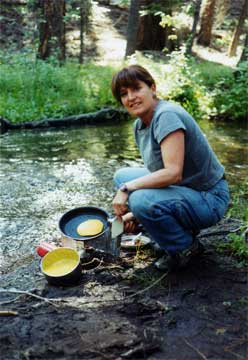
Need syrup? In a separate pan, mix 1/2 C brown sugar and maple flavoring, and just enough water to dissolve sugar. Heat, then reduce by boiling until syrup consistency. Watch it carefully or you may end up with taffy . . . or worse.
Step 7: Enjoy with a friend.
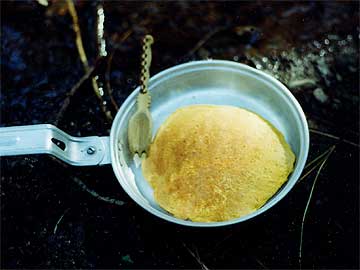
![]()
We hope the information on the PrimitiveWays website is both instructional and enjoyable. Understand that no warranty or guarantee is included. We expect adults to act responsibly and children to be supervised by a responsible adult. If you use the information on this site to create your own projects or if you try techniques described on PrimitiveWays, behave in accordance with applicable laws, and think about the sustainability of natural resources. Using tools or techniques described on PrimitiveWays can be dangerous with exposure to heavy, sharp or pointed objects, fire, stone tools and hazards present in outdoor settings. Without proper care and caution, or if done incorrectly, there is a risk of property damage, personal injury or even death. So, be advised: Anyone using any information provided on the PrimitiveWays website assumes responsibility for using proper care and caution to protect property, the life, health and safety of himself or herself and all others. He or she expressly assumes all risk of harm or damage to all persons or property proximately caused by the use of this information.
© PrimitiveWays 2016